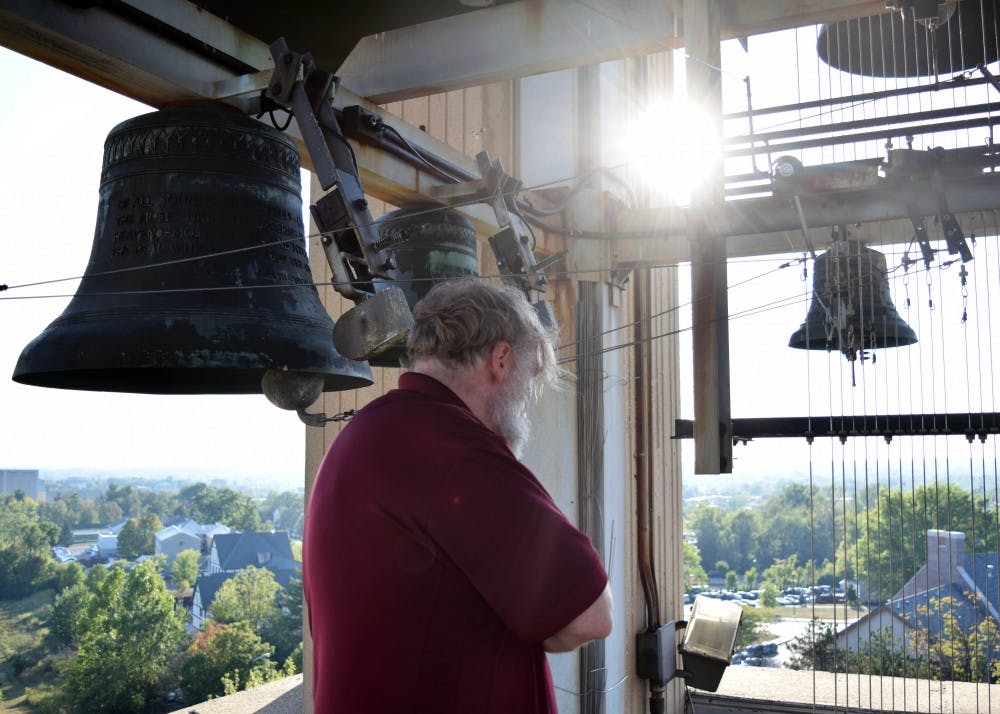John Gouwens, a frequent guest carillonneur at IU, descended the Metz Carillon tower to greet those who attended the instrument's final performance. His large, red-orange beret overshadowed much of his face. Listeners asked him to autograph programs and answer questions .
An hour earlier, the sun beat down on a hill littered with about 100 people. They were splayed out on blankets, sitting in lawn chairs and squeezed together on benches to listen to the Metz Carillon Farewell Concert. At the top of the deteriorating limestone tower that houses the carillon was Gouwens, preparing for the recital.
The performance of the carillon began at 4 p.m. with “Introduction et musette,” by Jacques Lannoy. To make music on the organ-like instrument, Gouwens played a keyboard that controlled the bells within the tower.
Sophomore Brett Roberts said he had never been to a carillon recital before.
“It’s a unique instrument that you don’t get to hear every day,” Roberts said.
Sophomore Sean Harrington was listening to the recital with Roberts and said that he saw the event on Twitter and thought it looked fun.
“It’s cool that we get to see it here and the transition to the new one in the bicentennial year,” Harrington said.
Gouwens said many of the selected pieces had a personal touch to them. Two of the included pieces were dedicated to Gouwens and written by IU alumni Neil Thornock and Lee Cobb.
“I'm making a point in this case to play some things by IU alumni,” Gouwens said. “I figured, it's kind of a commemorative recital in a way looking back.”
Gouwens also said that two pieces in the performance, “Preulude on ‘The King’s Majesty’” and “From Four Intermezzos,” he learned as an IU student his first year at the school, both of which he performed on the Metz Carillon back in 1975.
When the performance ended, Gouwens appeared in a lookout beneath the bells. His wave and short bow to the crowd were met with enthusiastic applause. “Bravo!” one man shouted up to him.
John Gouwens
Gouwens works full time as Organist and Carillonneur at the Culver Academies, a college prep boarding school in Northwest Indiana. Gouwens studied organ at IU for two years but left because of the inability to learn carillon at the University. Gouwens holds bachelor's and master's degrees in organ from the University of Michigan and the University of Kansas, respectively. He said that he knew from the age of 2 that he wanted to be an organist.
Gouwens said that at the time, his family lived in Buchanan, Michigan, and his father was the pastor at the Presbyterian church. He liked that the chimes of the organ were visible, and the organist at the church demonstrated the piano-type hammer action for him. Gouwens said that after the organist was finished with service, she would let him try.
"I couldn't really play anything properly, I was a 2-year-old after all, but I learned right away how to play the chimes,” Gouwens said. “So, this interest in bells really does go all the way back.”
It wasn’t until moving to Fort Wayne, Indiana, when he was 6, that Gouwens took an interest in carillons. Some of the churches in his town had electronic imitation carillons.
“That got me curious enough that I did a whole lot of reading on the subject,” Gouwens said. “And there were books in the library about bells in general and some specifically about carillons.”
Gouwens said he came to IU as a freshman in 1975, but he transferred at the end of his sophomore year to the University of Michigan.
“Being in-state, when it came time to go off to college, I went to IU first,” Gouwens said. "My freshman year, there was no one to teach carillon at IU, which was a bit frustrating because it was something I was interested in trying to do.”
Today, IU still does not have a carillon program for students. However, Gouwens said that when he comes down to play at IU, he will usually teach a few students.
Gouwens said that his sophomore year at IU, an assistant instructor who had gone to a dedicated carillon school in Belgium taught a few students each week. He said that learning the carillon immediately surpassed his expectations.
"When I left IU, I told them the negative situation of the carillon at IU was a big factor in my changing schools,” Gouwens said.
Today, Gouwens comes to IU once or twice a year to do performances. Because of this, Gouwens was brought on as a consultant for the renovation of the Metz Carillon.
Future of the Carillon
This October, the Metz Carillon will be dismantled and its bells sent back to the Netherlands to be refurbished. Four bells will be added to bring the instrument to grand carillon status, of which there will be 27 in the world once this project is complete. A much larger selection of music has been written for grand carillons.
Patrick Fischer, academic specialist and organ curator at the Jacobs School of Music, said that in addition to revitalizing the bells, the project will design a new tower to house the bells in the Arboretum, just north of the Henry Radford Hope School of Fine Arts. The project is a part of the bicentennial program and will be rededicated in fall 2019.
“The location means in order for people to hear it, they have to know ahead of time that there’s a recital,” Fischer said.
Fischer said he hopes the new location will allow people to stumble onto the instrument and hear it being played more frequently.
The 78 steps of the Metz Carillon lead up to a platform completely open to the elements save for some iron bars and torn mesh netting keeping people from falling out the side. The carillon itself is housed in a separate room on the same floor with floor-to-ceiling glass windows. A vertical ladder leads to the bells above, which are even more exposed to the elements.
Each bell has a different inscription on it from various pieces of literature. Inscriptions included quotes from Dante Alighieri’s “Purgatorio,” in Italian, Percy Shelley’s “Music When Soft Voices Die” and Walt Whitman’s “O Captain! My Captain!” among others.
“If music be the food of love, play on, / Give me excess of it; that surfeiting, / The appetite may sicken, and so die,” one bell read from William Shakespeare’s “Twelfth Night.”
In the corner of the carillon room was a mechanism that Gouwens said used to function as a clock system which would strike the hour and play a few tunes. However, a malfunction in its first year of use once caused it to play continually throughout the night. Gouwens said this did nothing to endear the instrument to the neighborhood.
Gouwens said that aside from the renovation and additional bells, the new tower’s acoustics will vastly improve the sound of the carillon.
“The sound is bright, not as much character, and actually kind of weak in the bass,” Gouwens said. “The tower that's there now is acoustically just awful. It's wide open to the elements so the sound is really quite raw.”
Gouwens also said he knew of a carillon in the Netherlands that was exactly a twin to the Metz Carillon, which had undergone a similar renovation.
“It was exactly the same range and it was in a free-standing tower also that was acoustically really dead,” Gouwens said. “Well, some years later that carillon was moved into the tower of a church right in the heart of town. I played on that carillon once and it was a night and day difference. It was literally exactly like the way the Metz Carillon was installed, but just putting it in a nice tower made all that difference.”






